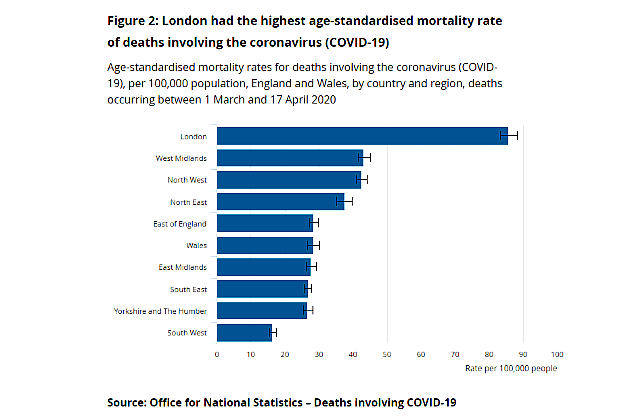Wimbledon's Coronavirus Death Toll Revealed
Figures showing fatalities at a local level published for the first time

Detailed data about the coronavirus outbreak has been published which shows that up until the middle of last month 13 people in the Wimbledon area have died from the disease.
The Office of National Statistics (ONS) have published the number of fatalities at a very local level for the first time. The data is based on the analysis of registration of deaths including the residence of the deceased between 1 March and 17 April 2020 and where coronavirus was the underlying cause or was mentioned on the death certificate as a contributory factor.
Roughly speaking Wimbledon is divided into five Middle Layer Super Output areas by the ONS. Based on a very limit set of data, the area seems to have got off relatively lightly thus far. In some cases high death rates in a particular area can be caused by the number of care homes located there. Raynes Park had the highest death rate in the vicinity with 11 fatalities and there were six in Colliers Wood.
| Area | Covid-19 Deaths | Total Deaths | Covid-19 (%) |
|---|---|---|---|
Wimbledon Park & Durnsford Road (MSOA Merton 001) |
1 |
6 |
17 |
Wimbledon Common (MSOA Merton 002) |
4 |
15 |
27 |
Wimbledon Hill (MSOA Merton 004) |
4 |
14 |
29 |
Wimbledon Broadway North (MSOA Merton 003) |
2 |
9 |
22 |
South Wimbledon (MSOA Merton 006) |
2 |
21 |
57 |
Colliers Wood (MSOA Merton 005) |
6 |
14 |
7 |
Merton Park (MSOA Merton 015) |
3 |
8 |
38 |
Raynes Park (MSOA Merton 016) |
11 |
31 |
35 |
Cottenham Park (MSOA Merton 010) |
3 |
11 |
27 |
Source: ONS
Merton has a slightly below average death rate for London boroughs with 117 people dying from Covid-19 giving a rate of 83.0 per 100,000 people. All of the top ten were London boroughs with Newham having the highest death rate of 144.3.
| Death Rates by London Borough to 17 April | ||||
|---|---|---|---|---|
| Borough | All Deaths | Rate | Covid-19 Deaths | Rate |
| Newham | 421 | 298.7 | 208 | 144.3 |
| Brent | 550 | 256.9 | 304 | 141.5 |
| Hackney | 304 | 263.5 | 146 | 127.4 |
| Tower Hamlets | 260 | 239.3 | 132 | 122.9 |
| Haringey | 314 | 222.1 | 168 | 119.3 |
| Harrow | 487 | 229.2 | 241 | 114.7 |
| Southwark | 320 | 219.0 | 156 | 108.1 |
| Lewisham | 393 | 244.1 | 172 | 106.4 |
| Lambeth | 361 | 233.7 | 165 | 104.3 |
| Ealing | 538 | 230.4 | 239 | 103.2 |
| Hammersmith and Fulham | 220 | 209.7 | 100 | 96.4 |
| Waltham Forest | 343 | 210.8 | 151 | 92.5 |
| Barking and Dagenham | 271 | 229.5 | 103 | 89.2 |
| Enfield | 542 | 225.9 | 220 | 91.3 |
| Barnet | 687 | 216.9 | 287 | 91.6 |
| Islington | 227 | 208.0 | 88 | 80.7 |
| Greenwich | 376 | 230.9 | 140 | 84.6 |
| Croydon | 573 | 201.0 | 252 | 88.0 |
| Merton | 320 | 228.9 | 117 | 83.0 |
| Redbridge | 441 | 209.1 | 174 | 82.9 |
| Wandsworth | 345 | 209.7 | 132 | 80.2 |
| Westminster | 274 | 164.5 | 120 | 72.3 |
| Hillingdon | 447 | 199.8 | 164 | 73.0 |
| Kensington and Chelsea | 171 | 134.7 | 84 | 66.8 |
| Hounslow | 317 | 190.0 | 120 | 69.2 |
| Havering | 516 | 199.5 | 166 | 64.6 |
| Sutton | 322 | 188.2 | 96 | 56.7 |
| Camden | 214 | 127.9 | 91 | 55.2 |
| Bexley | 381 | 165.4 | 125 | 54.8 |
| Richmond upon Thames | 229 | 136.7 | 77 | 47.0 |
| Kingston upon Thames | 241 | 178.4 | 57 | 42.9 |
| City of London | 9 | 106.2 | 3 | 35.2 |
There were 90,232 deaths occurring in England and Wales that were registered by 18 April; 20,283 of these deaths involved the coronavirus. When adjusted for size and age structure of the population, there were 36.2 deaths involving Covid-19 per 100,000 people in England and Wales.
London had the highest age-standardised mortality rate with 85.7 deaths per 100,000 persons; this was statistically significantly higher than any other region and almost double the next highest rate.
The age-standardised mortality rate of deaths involving Covid-19 in the most deprived areas of England was 55.1 deaths per 100,000 population compared with 25.3 deaths per 100,000 population in the least deprived areas.

Nick Stripe, Head of Health Analysis, Office for National Statistics said, “People living in more deprived areas have experienced Covid-19 mortality rates more than double those living in less deprived areas. General mortality rates are normally higher in more deprived areas, but so far Covid-19 appears to be taking them higher still.”
Figures on deaths published by the ONS differ from those produced by the Department of Health and Social Care (DHSC) and the UK's public health agencies for two main reasons: the time between death and reporting of the death and the ONS's wider inclusion criteria.
May 3, 2020